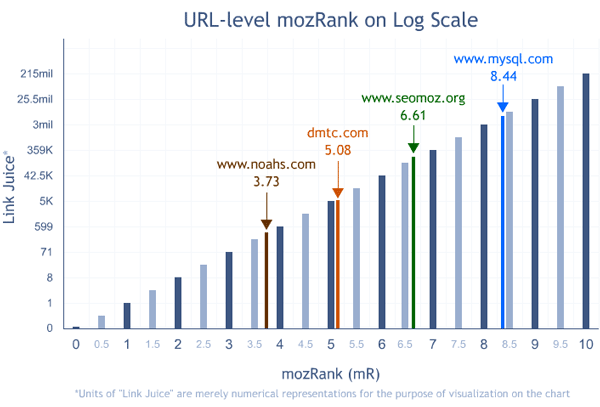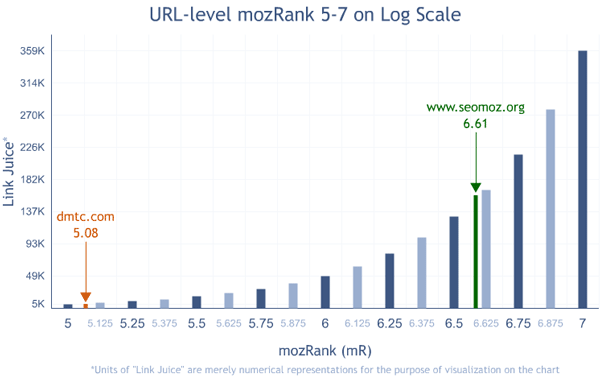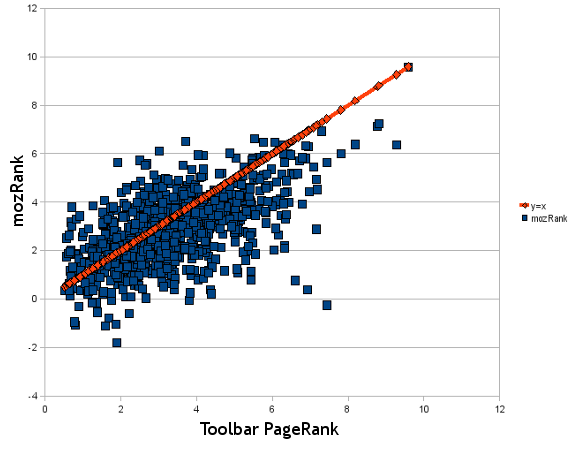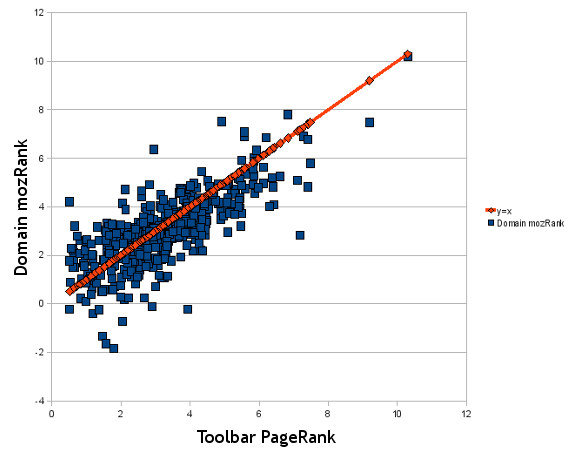mozRank and PageRank for Metrics Driven SEO
Judging by our analytics and the volume of Q+A about mozRank and PageRank, I'd say a lot of you are applying metrics to your SEO. And I don't just mean search engine referrals. Given the economy, it's great if you can lay out some hard numbers, connect that to results, and make a strong argument for the work that you do.
I know we're seeing our SEO business continue to grow, not shrink, even in this harsh economic climate. I think a lot of that is because we're able to provide good numbers to back up our strategy recommendations. But even with the expertise on our SEO team and out in the community, I still see a few common questions about mozRank and PageRank, and what these mean for real-world SEO:
- What's the scale for mozRank? And why do I care?
- What does mozRank measure compared to Domain mozRank?
- How does mozRank compare to or differ from PageRank? Why should I use one or the other?
- What does PageRank really tell me about a page? How is it limited and what can I do with this knowledge?
These are great questions. We've got some discussion in our Linkscape help center around these, but it's a little technical and product focused. And we'd prefer to tell everyone (not just PRO members) something about SEO here.
If you'd like, you can jump straight to the takeways. By the way, when I say "PageRank" below I mostly mean Toolbar PageRank, the green fairy dust in your Google Toolbar.
First, on to scales. Both mozRank and PageRank (both academically and in the real world) have very few pages at the top (mR/PR 10) and many, many pages at the bottom (mR/PR 1). Because there's such a big disparity here, both of them have a handy 10 point scale, as illustrated below.

You'll notice the Y-axis is showing a hypothetical Link Juice metric on a log scale. So where we have mozRank 4, you'll see that corresponds to a hypothetical link juice value of 599, and mozRank 5 corresponds to 5,000. This just reflects the relative effort to get these mozRanks, whether this be links, authoritative endorsements, etc.
Take a mozRank or PageRank 5 page: one point above PageRank 4, one point below PageRank 6: one point in both cases. But the work you put in to go from 4 to 5 is quite different from the work you do to go from 5 to 6. For beginners it's frustrating to hit a particular level of PR or mR and feel like you've plateaued. When this happens, it's time to sharpen your pencils because you've got to break out some new techniques.
FYI, we set mozRank so that each level is ~8 times as much link juice as the prior level. To show this in another way, here's the same graph, but we've taken out the fancy scaling and just show the gradations between mozRank 5 and 7.

Suddenly you can see the real difference in SEO effort between a mozRank 5.08 and a mozRank of 6.61, and the work left until mozRank 7. Show this the next time someone gives you a hard time about that link building effort you're making. Or better yet, the next time you're link building, be sure to measure where you are today, and choose the right link building tactics. What worked to get you to mozRank or PageRank 5 just isn't going to cut it if you're going after that elusive 7.
When people say site PageRank, they're really talking about the link profile of the whole domain: what other sites are linking back? mozRank and (the original academic form of) PageRank both measure only links between pages. This ignores any factors about content, anchor text, domain age, authority, or trust. Domain mozRank and the concept of site PageRank are both interested in only links between sites. This still ignores factors about content or anchor text or domain age. While mozRank is scoped at the page level and measures reach by links to that page, Domain mozRank is scoped at the whole domain and measures how broadly the domain is referenced across many different domains. In this case, many links from a single domain don't help, but a few links from each of many different domains does help.
But typically one uses PageRank of the homepage to measure this. PageRank doesn't do a bad job of this, but it's not directly measuring this effect. Inside Linkscape (and exposed on the mozBar), we show Domain mozRank, which does directly reflect this, on the same kind of a scale described above.

Each level of Domain mozRank is about five times the juice of the prior level. This reflects the fact that there are many more pages than domains. But you get the same issues trying to jump from DmR 5 to 6 compared to 4 to 5. Getting more links from the same domains already linking to you isn't going to help your site-wide link profile. So if you're stuck at DmR 5, it's time to reach a little more broadly, engage in some new communities, and partner with some new sites.
So what about PageRank? Why do I keep talking about mozRank if Google isn't using it in their algorithms? That's a very valid question. We are confident, and plenty of expert SEOs agree that Google cares about links. They care about links from authoritative domains more than links from non-authoritative domains. And once you've gotten those links, the links you give out count for more. This is exactly the intuition we capture in mozRank and Domain mozRank. In fact, we've done a lot of studying and comparing mozRank and PageRank and we've found something really encouraging, and something a bit surprising.

* I've included a small amount of noise in PageRank (+/- 0.5) because PageRank is only provided with 10 gradations (e.g., PR 5 or 6 but never 5.34). This causes bunching in graph, which makes interpretation difficult.
This graph visually shows how mozRank compares to PageRank. The x-axis represents toolbar PageRank* of a page, and the y-axis represents mozRank for the same page. I've included the line y=x, which shows what perfect correlation would look like. For you stats junkies the Pearson's correlation coefficient is 0.48, which is good, but not perfect correlation.
We're pleased with this correlation. But by PR 4, mozRank starts to fall below PR, in some cases by at least a point. Our rule of thumb is that mozRank should be within a point or two of PageRank. This gets at data to support a belief many of you have had for a long time: Toolbar PageRank is correlated with site-wide authority and trust effects, beyond just page-level links. This can make things difficult for the metrics driven SEO: how can you measure your current position, and progress against different ranking factors, when the metrics you've got combine effects?

The Pearson's correlation between Domain mozRank and PageRank of the homepage of the domain of 0.71. This is a much more significant correlation than the page-level correlation between mozRank and PageRank. This time, we see much more significant clustering around the perfect correlation line y=x. And this time we see much less of the underestimating we saw with page-level mozRank. This suggests that Toolbar PageRank is showing several factors, including page-level linking, but also site authority and trust. And those factors are combined into a single score. Using PageRank alone can leave plenty of question marks about your strengths and weaknesses.
For the metrics driven SEO, this implies a few things:
- A high Toolbar PageRank for a page might not indicate a widely popular page. In fact, the page might be very lightly linked to, but might instead be reaping the rewards of being on a strong domain (e.g., some Wikipedia pages).
- Analyze the profile of the whole domain during the initial audit process, and not just specific pages. A new or unknown page might receive a high PageRank just by being on a strong domain. PRO members can try out the labs backlinks analyzer and choose "root domain" or "just this page" to see these two profiles.
- Work on site-wide performance, and then focus it. Gain authority for your whole domain, then focus that strength through link sculpting, on-page key word factors, and anchor text.
- Use fine grained metrics. Where appropriate, metrics like mozRank and Domain mozRank along with some comparisons to the competition can give an audit some powerful, targeted conclusions about strengths and about what is missing. We're certainly doing a lot of this in our own consulting.
The online marketing space is filled with measurements: analytics, conversions, cost-per-click. A lot of SEO is something of an art requiring high-level expertise. But there's plenty of room for measurement here too. Check out your site profile, check out your strong and weak pages. Measure the authority of your site. Prioritize your work based on your known strengths and weaknesses. And show your stakeholders not just what you're doing but why, and how that's changing.
With the economy in the shape it's in, the people who can measure their work and validate their assumptions are the people who are going to survive. And they're not just going to survive, but they'll thrive as they pick up the pieces the rest of us leave behind.



Comments
Please keep your comments TAGFEE by following the community etiquette
Comments are closed. Got a burning question? Head to our Q&A section to start a new conversation.